Top News
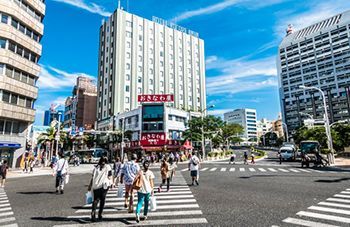
January 10, 2019 Ryukyu Shimpo
On January 9, travel search engine KAYAK announced its popular spring break travel destinations ranking for 2019, which was based on search data.
KAYAK is a leading subsidiary of one of the world’s largest online travel agencies, Booking Holdings.
Among the travel destinations around the world, Okinawa placed third.
The number of searches drastically increased by 229 percent in 2018 compared to the previous year.
Rome placed first in the ranking, while Osaka placed second.
Okinawa was second only to Osaka for being a popular destination within Japan.
Places like Guam and Seoul also ranked high for their tourist spots and beach resorts. This shows that Okinawa is popular as a winter destination.
KAYAK Japan and South Korea General Manager Masahiro Yamashita analyzed the situation as, “The popularity of resorts come not just from established spots, but also scattered areas throughout Japan and Asia.”
For the Japanese version of KAYAK, search data between January 1, 2018 and December 5, 2018, along with travel dates between February 1, 2019 to March 31, 2019 were used to compare data from the previous year with the same time frames.
(English translation by T&CT and Chelsea Ashimine)
Go to Japanese
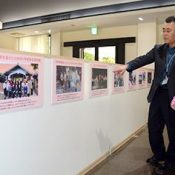
January 5, 2019 Ryukyu Shimpo
By Chikako Maemori
On June 23, the Himeyuri Peace Museum in Itoman City will mark 30 years since its opening. On January 4, the Ryukyu Shimpo learned that the museum is planning to renew its exhibitions in 2020.
This year, the museum will begin planning for the renewal in earnest as part of undertakings to mark its 30th anniversary.
This will be the second renewal after a first in 2004, and the museum plans to decide on new exhibits with input from the survivors.
“It is an important opportunity for the survivors and museum staff who were born after the war to work together,” museum director Chokei Futenma, 59, explained with excitement.
Many schools bring students on class trips to the museum.
“Fifteen years have passed since the last renewal,” explained curator Katsumi Maedomari.
“For junior high and high school students, the war feels further away than ever.”
She said that going forward, the museum aims to curate its exhibits in ways that junior high and high school students will be able to understand.
The Himeyuri Peace Museum was founded in 1989 to advocate the importance of peace and commemorate 227 students and teachers from the Okinawa Shihan Women’s School and Okinawa Daiichi Women’s High School who were mobilized to care for wounded soldiers during the Battle of Okinawa.
It became known nationwide as a place where visitors could hear the surviving Himeyuri students in person give testimony as “witnesses” about their experiences.
In 2004, the museum overhauled its exhibitions in order to make them more accessible to the younger generations.
It increased explanatory texts and added testimony video footage for ease of comprehension.
At the end of March of last year, more than 22.19 million people had visited the museum, but the number of visitors has decreased in recent years.
The museum was built by survivors and has been a place where survivors teach the next generations about the horrors of war.
Since its founding, former Himeyuri teachers and students have served as directors of the museum, but last year the museum got its first director born in the post-war era.
“I want to run the museum with an eye toward the future,” says director Futenma.
(English translation by T&CT and Sandi Aritza)
Go to Japanese
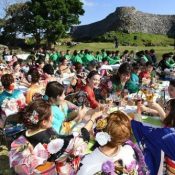
January 5, 2019 Ryukyu Shimpo
NAKIJIN—Coming-of-age Day is a national holiday celebrated annually on the second Monday of January.
Since ringing in the new year, municipalities all over Okinawa have hosted coming-of-age ceremonies for those who recently turned, or will be turning 20 years old.
The village of Nakijin held its coming-of-age ceremony at the Nakijin Castle Ruins, a UNESCO world heritage site, on Jan. 4. It is the first time the site has hosted such a ceremony.
In total, 87 newly minted adults joined to celebrate the beginning of a new chapter in life.
Hosting the ceremony at Nakijin Castle Ruins was made possible by an executive committee formed by members who are coming of age this year.
“I wanted to take advantage of the world heritage site and share this moment with everyone,” said Koshiro Shinjo, 20, a committee member and first year student at Nara University.
Participants dressed up in suits and formal kimonos—the hakama and furisode, as they reunited with friends and snapped photos of each other.
Shinjo delivered a speech on behalf of his peers at the ceremony.
“I hope to be an adult that can make his own decisions in overcoming various challenges with imagination. I ask for your guidance and emboldening,” he said.
Village mayor Haruki Kyan also gave words of encouragement: “I hope you mature into magnanimous adults who are proud to call Nakijin home.”
(English translation by T&CT and Monica Shingaki)
Go to Japanese
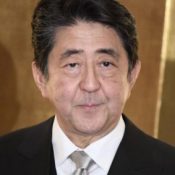
January 8, 2019 Ryukyu Shimpo
Prime Minister Shinzo Abe made a false claim about the land reclamation work in Henoko Bay, part of the relocation of MCAS Futenma (located in Ginowan, Okinawa) to the Henoko area of Nago, while on a political discussion show this past Sunday, January 6. The prime minister stated, “The coral in the landfill area is being relocated,” however the reality is that in “landfill zone 2-1,” an undersea region in Henoko where land reclamation is currently taking place, no such relocation of coral is taking place.
In the total land reclamation area, there are approximately 74,000 colonies of coral that need to be moved, however as of January 7, only nine Porites okinawensis colonies in other area had been relocated.
The Okinawa Defense Bureau (ODB) policy was to at first relocate a single colony of the endangered Stylaraea coral from the area near where landfilling was to take place. However, as they would have had to obtain a special permit for gathering the coral, as well as use special equipment that would safely enclose it, the ODB opted for a construction plan that would avoid having to move the coral.
Regarding the prime minister’s statement, Okinawa Governor Denny Tamaki posted on Twitter January 7, “Prime Minister Abe… That was taken from someone’s lecture wasn’t it? That is not what is happening. So, we are calling [your statement] into question.”
Tokyo Keizai University Associate Professor Nami Okubo, an expert in coral biology, said, “His statement is does not accurately represent the situation. Even if the coral is relocated, the survival rate is low, and furthermore it does not make for good environmental conservation policy.”
The ODB is also only targeting coral of one meter in size or more for relocation, anything under that will not be relocated.
Regardless, the nine colonies relocated are not coral from “landfill zone 2-1.” Moreover, none 39,000 colonies of coral that the ODB has targeted for relocation in their permit application submitted to Okinawa Prefecture are located in “landfill zone 2-1.” The permit has not yet been granted by the prefecture.
Abe also stated, “Endangered species along the coast will also be sifted from the sand and moved to another part of the coast.” While there are examples of the ODB collecting shellfish and crustaceans by hand and moving them, there does not seem to be any evidence that they are being “sifted from the sand,” and moved.
(English translation by T&CT and Sam Grieb)
Go to Japanese
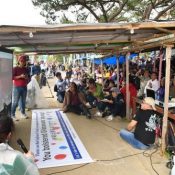
January 6, 2019 Ryukyu Shimpo
On January 5 citizens gathered in front of the gates to Camp Schwab to protest construction of the Futenma Replacement Facility in Henoko. Customarily, on the first Saturday of the New Year Okinawans come together for a large protest action there. This year about 1000 people participated and renewed their resoution to stop construction of the new base. Participants held a video call with Robert Kajiwara, a 32-year-old 4th-generation Okinawan-American living in Hawaii who created a petition calling for US President Trump to suspend land reclamation work until the prefectural referendum is held in February. Together, Kajiwara and the protesters pledged their continued efforts against construction in Henoko.
Kajiwara greeted those gathered with the Uchinaguchi word “Haisai,” and was moved to tears upon seeing the sit-in protestors. On the video call, Kajiwara and 53-year-old 4th-generation Okinawan-American Eric Wada thanked the protestors from the heart for protecting Okinawa’s ocean and human rights.
Those listening burst into applause at these words from Kajiwara, “To me each one of you is a hero, as you have encouraged me to conduct a signature gathering campaign. Now there will surely be a response from the president.”
Okinawa Peace Movement Center Chairman Hiroji Yamashiro spoke emphatically: “Let’s make a spreading display of Uchinanchu solidarity throughout the world. Okinawans will not give up.”
First-year graduate student Reona Nishinaga of Okinawa Prefectural University of Arts, who drafted up leaflets for signature collecting, said, “Even without going to the gate there are things that can be done over the internet and in other ways. I hope to collect [signatures from] 200,000 people.”
January 7 is the deadline for the petition to reach 100,000 signatures. As of January 5 at 4:30 p.m. the petition had collected 177,291 signatures.
On January 7 Kajiwara joined with others to rally in front of the White House. In solidarity, on January 8 starting at 4:00 p.m. Okinawans rallied at the Ishinda gate to Camp Foster. Although land reclamation work in the ocean continued, no construction vehicles hauling materials were spotted outside the gate.
(English translation by T&CT and Erin Jones)
Go to Japanese
January 1, 2019 Ryukyu Shimpo
We have entered the final year of the Heisei era. 2019 looks to be a year in which the existence of democracy in Okinawa, and subsequently Japan as a whole, will be brought into question. This is because while an overwhelming majority of Okinawans oppose it, the Japanese government is ramming through land reclamation at Henoko as part of the MCAS Futenma relocation.
If this continues in its current state, the heavy handed methods suppressing the will of Okinawan residents has the potential to expand out to the rest of the country. If the government’s recklessness is not stopped, it will create an awful precedent for the future.
This year also marks the 140th anniversary of the 1879 annexation of the Ryukyus by Japan (also known as the Disposition of Ryukyu). In the time since, the government’s stance of treating Okinawa as a subordinate has not changed.
The Ryukyu Kingdom has been under foreign control since the 1609 invasion by the feudal domain of Satsuma, however its status as a nation was preserved due to its long-standing tributary relationship with the Ming and Qing dynasties of China. In 1872, the Meiji Empire unilaterally established the Ryukyu Kingdom as the Ryukyu Domain, with the King of Ryukyu as its administrator.
Just before this happened, Japanese Minister of Finance Kaoru Inoue proposed, “Our ambiguous relationship with the Qing dynasty has continued for hundreds of years, however with the coming of the Meiji Restoration, this cannot continue. Taking steps to expand the Japanese empire is needed. In doing so, it would not be good to simply take by force. Rather, we should shortly invite their chieftain (the King of the Ryukyus), strictly rebuke him for his disloyalty, and then formally register the land and titles.”
The proposal was a fabrication, one which downgraded the King of the Ryukyus to a “chieftain,” and annexed the islands unilaterally for the “crime of disloyalty.” The proposition was not adopted, however it sparked the conversation about a Ryukyu annexation. It painted a clear picture of how the Meiji Empire viewed Okinawa.
After Okinawa was broken off from Japan in the Peace Treaty of San Francisco in 1952 before being reincorporated into Japan, leaving behind the expansive U.S. military bases in opposition to Okinawan wishes, the forcing of new base construction at Henoko can only be seen as the fourth “Disposition of Ryukyu.”
In the Pacific War, Okinawa was used to buy time in defense of the Japanese mainland, and Japan conscripted a vast number of local residents for the land portion of the battle on the island. As many as one-in-four residents would become a casualty in the ensuing battle.
Okinawans dream of a peaceful Okinawa. The U.S. military base exists namely so that it can be used for an attack in an emergency. It is only natural for us to demand that the base burden placed on Okinawa be lessened, if only a little.
The Japanese government is using the 2013 approval for land reclamation given by former Okinawan governor Hirokazu Nakaima as their banner. However, Nakaima also stated publicly, “I request facilities be relocated outside of Okinawa.” It is also clear that a large majority of Okinawans opposed his decision to allow land reclamation. This was made clear in the two subsequent gubernatorial elections, with the anti-base candidate winning in landslides both times.
It should be mentioned that people who are feeling threatened by an over-authoritarian Japanese government is not limited to Okinawa alone. This is shown by the results of a national telephone poll conducted by Kyodo News, where 56.5% of respondents answered that they “do not support” the government’s stance on base relocation.
The Japanese government has shown time and again that their stance towards Okinawa is to ignore their will and rule with an iron fist. So, I want to ask them this question. Is Japanese democracy merely a sham? I want them to pause for a moment, and think very carefully about this.
(English translation by T&CT and Sam Grieb)
Go to Japanese
January 4, 2019 Ryukyu Shimpo
Over the course of three days starting on December 22 last year, the Ryukyu Shimpo, the Okinawa Television Broadcasting Company (OTV), and JX PRESS Corporation conducted a telephone public opinion poll of constituents in all regions within Okinawa Prefecture. The poll asked voters whether they plan to attend the prefectural referendum concerning their support or opposition of land reclamation in Henoko, Nago City, as part of construction of a replacement facility for MCAS Futenma. When asked, 77.98 percent of respondents said they “will attend,” and 9.81 percent answered they “will not attend.” The results indicate that a high ratio of constituents intend to vote in the prefectural referendum.
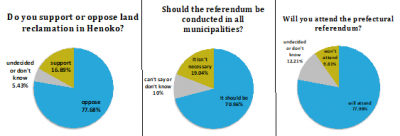
Those who answered they are “undecided or do not know” if they will attend account for 12.21 percent of respondents.
When asked if the referendum should be hosted in each city, town and village, 70.96 percent said “it should be conducted in all municipalities,” outnumbering the 19.04 percent who answered “it is not necessary to conduct it” in all municipalities.
Out of those who plan to attend the referendum, a large portion of 77.68 percent said they oppose land reclamation work, and 16.89 percent said they support it. The results brought to light that even within the land reclamation support faction, there is a definite portion of people who intend to vote in the referendum.
The referendum will be conducted on February 24 this year. Still, as of Janurary 3 the mayors of Ginowan City and Miyakojima City have openly decided not to host the referendum, and the mayors of Okinawa City, Uruma City, Itoman City, and Ishigaki City are putting hosting the referendum on the backburner. Looking at the northern part of the main island, the middle and southern part of the main island, Miyakojima, and the Yaeyama Islands, the ratio of respondents who think that the referendum should be conducted in each city, town and village greatly exceeds the ratio of those who think it is unnecessary to conduct the referedum in each municipality.
When asked if the Japanese government should accept the results of the prefectural referedum, 69.04 percent said that the government “should accept the results,” and 16.83 percent said “it is unnecessary” for the government to accept the results.
Concerning the central govenment pushing forward with land reclamation work despite the Okinawa prefectural government (OPG) revoking the land reclamation permit, 24.61 percent of respondents said they “strongly support” or “somewhat support” the government’s actions. Alternatively, 68.94 percent said they “completely oppose” or “somewhat oppose” the government’s actions.
When answers from the middle and southern region of Okinawa Island are considered separately, including places like Ginowan City, Okinawa City, Uruma City, and Itoman City where it is still unclear if the referendum will be held, those who say they “will attend” the referendum account for 78.03 percent of respondents, and those who say the referendum “should be held in each municipality” account for 70.74 percent of respondents. The mayor of Miyakojima City has declared that the city will not be holding the referendum, yet in Tarama Village (within Miyakojima City) 80 percent of respondents said the referendum “should be held in each municipality.”
The poll also assessed if the prefectural referendum is common knowledge by asking respondents if they knew about the referendum. Out of respondents, 90.87 percent answered that they knew about the referendum already.
Regarding Okinawa Governor Denny Tamaki’s stance on stopping relocation of MCAS Futenma to Henoko, 74.72 percent of respondents “strongly support” or “somewhat support” his position, and 19.52 percent “completely oppose” or “somewhat oppose” it.
(English translation by T&CT and Erin Jones)
Go to Japanese
………………………………………………………………
Polling Method:
Last year over December 22, 23, and 24 the three news agencies used random digit dialing (RDD), a process by which a computer randomly generates telephone numbers and calls them, to conduct the poll. A recorded voice posed the questions. Altogether 1,687 numbers were dialed, and 1,039 people answered the poll.
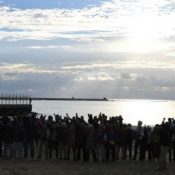
January 3, 2019 Ryukyu Shimpo
In the early morning of January 1, citizens opposed to the construction of the new base gathered at Henoko beach and held Hachiukushi. Facing toward the sunrise, 316 citizens renewed their resolution to oppose the construction of a new base.
As they wished for a bright new year, singers and dancers performed Kagiyadefu and Tanchame. Around 7:30 a.m. sunlight emerged from between the clouds that covered the sky and shone on the Henoko sea and beach.
Co-representative of the All Okinawa Coalition Susumu Inamine said, “The future of new base construction will be like sunlight through the clouds, like today. I want to make this year a good year.”
Co-representative of the Helicopter Base Objection Association Hiroshi Ashitomi stressed, “The opposition to construction of the new base is a fight for the people of Okinawa to decide the future of Okinawa. Although the government is forcing construction through, we fight to change society.” Upon hearing his words, citizens raised their fists.
(English translation by T&CT and Megumi Chibana)
Go to Japanese
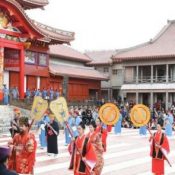
January 3, 2019 Ryukyu Shimpo
On January 1, the Shurijo Castle Park New Year’s Celebration commenced in Naha City. Many people, such as families and tourists, visited and gave a round of applause to the magnificent ceremony. Fusako Sasaki, 75, visiting from Sendai City, Miyagi Prefecture said, “I can feel the unique culture of Okinawa. The sound of Uzagaku was distinctive and very nice.” The ceremony took place during the first three days of the New Year.
During the morning of January 1, a Ryukyu Kingdom Era New Year’s Ceremony, Chohai-Okishiki with a three-part composition was reenacted. The first part, Ninufanu-unufe celebrating the New Year began as the sound of Uzagaku rang throughout. The king, royal family, high government officials of the kingdom, and representatives of common folk bowed at the altar to pray for peace and tranquility in the New Year.
On January 3, the Appearance of the King and Queen took place, wherein Uzagaku was played and the king and queen appeared in the courtyard. There was also a traditional Ryukyuan performance at the Shichauuna courtyard.
(English translation by T&CT and Chelsea Ashimine)
Go to Japanese
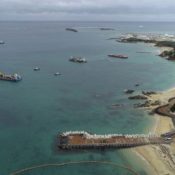
December 22, 2018 Ryukyu Shimpo
On December 21, it came to light that construction of the seawalls on the Oura Bay side of Cape Henoko, planned for FY2018, is to be postponed to FY2020 or beyond.
Building the seawalls is part of construction of the Futenma Replacement Facility in Henoko, Nago City.
Approximately 52.5 billion yen appropriated for construction expenses in FY2018 went unused, and on December 21, the Cabinet decided also not to include related expenses in the FY2019 draft budget.
It has been established that there is an area of soft seabed on the Oura Bay side that will need ground reinforcement, which likely means land reclamation work will take longer than initially planned.
According to the Ministry of Defense (MOD), the Okinawa Prefectural Government’s (OPG’s) revocation of the land reclamation permit delayed construction work, and the geological boring surveys have not been completed.
An MOD official stated that this means there is no way to know when seawall construction on the Oura Bay side can begin. 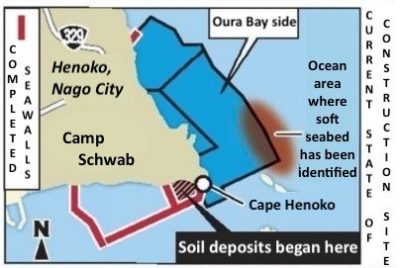
Now, the plan is to establish concrete caisson-type seawalls to the north of Cape Henoko on the Oura Bay side.
Yet up to this point the MOD geological boring survey of the planned land reclamation site has verified that the hardness of some ground in the depths on the Oura Bay side has an N-value of zero on the penetration resistance scale.
The MOD is conducting additional surveys and is comprehensively judging the results including the firmness of the ground.
Still, the MOD has not yet submitted these results or a detailed design for the Oura Bay side to the OPG.
According to the plan that the Okinawa Defense Bureau (ODB) submitted to the OPG concerning its land reclamation application, land reclamation was to start on the Oura Bay side.
However, this year the ODB first enclosed the shallow ocean area on the south side of Cape Henoko with seawalls, and began land reclamation there on December 14.
In the MOD draft budget for FY2019, 43.919 billion yen has been appropriated for land reclamation in the ocean area on the south side of Cape (based on contracts).
No money was appropriated for the caisson-type seawalls on the Oura Bay side for FY2019, so construction is being postponed until FY2020 or later.
The budget of 52.5 billion yen that went unused due to unexecuted parts of construction this year is being returned to the national treasury.
(English translation by T&CT and Erin Jones)
Go to Japanese
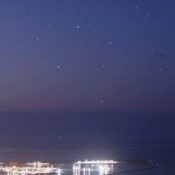
December 22, 2018 Ryukyu Shimpo
The season for viewing the Southern Cross, a constellation that symbolizes the southern sky, has arrived in Okinawa’s Yaeyama region.
In the early morning on December 20, the first photograph this winter of the Southern Cross was taken at the Ishigakijima Astronomical Observatory in Ishigaki City, Okinawa.
In Japan, the entire cross made up of four stars can only be seen from a few places, including the Yaeyama islands.
The constellation can be seen from the end of December until early June each year.
The Southern Cross is made up of two first-magnitude stars, one second-magnitude star, and one third-magnitude star. The four stars form a beautiful cross shape.
According to the Ishigakijima Astronomical Observatory, opportunities to view the Southern Cross are limited because the culmination time when the constellation is at its highest point and is most visible is near the time of sunrise, but the culmination time will get earlier as time goes by, and within one hour of that time will be the ideal time to view the constellation. On January 1, the culmination time will be 6:30 a.m.
“We were able to take a photograph to announce the beginning of the season for viewing the Southern Cross.
I hope people who go out early to see the new year’s first sunrise on January 1 will leave a little early and bring a pair of binoculars to look for the Southern Cross,” said Hidekazu Hanayama, director of the Ishigakijima Astronomical Observatory.
(English translation by T&CT and Sandi Aritza)
Go to Japanese











 Webcam(Kokusai Street)
Webcam(Kokusai Street)


